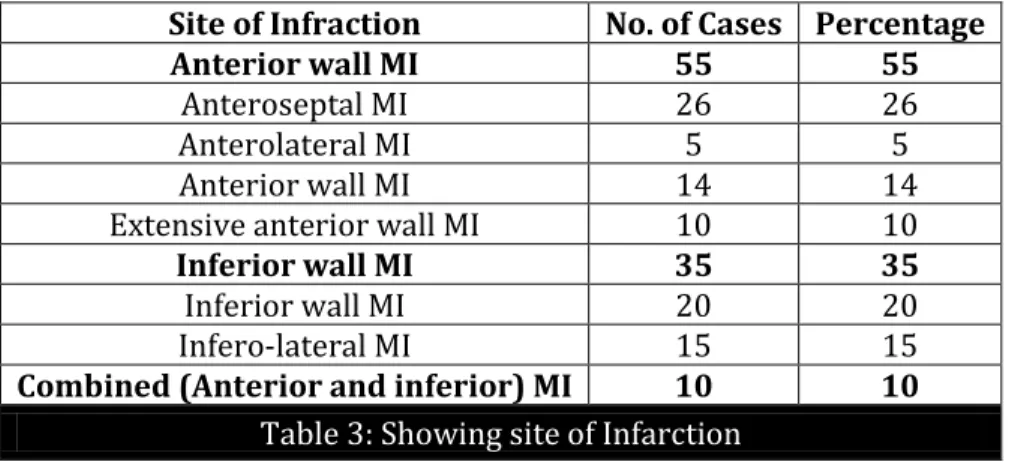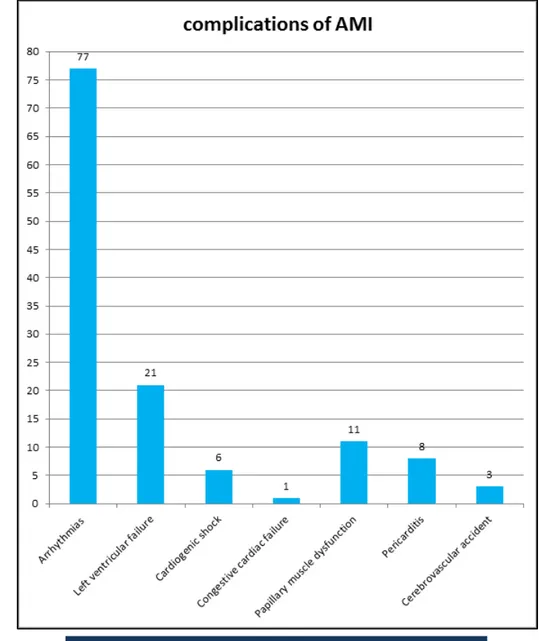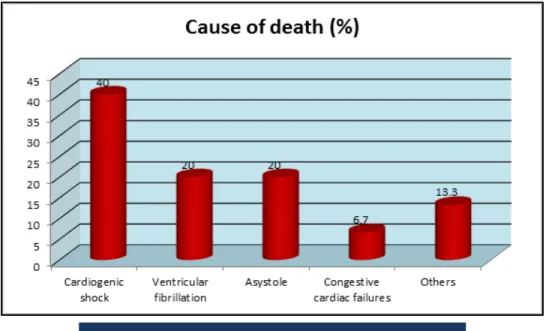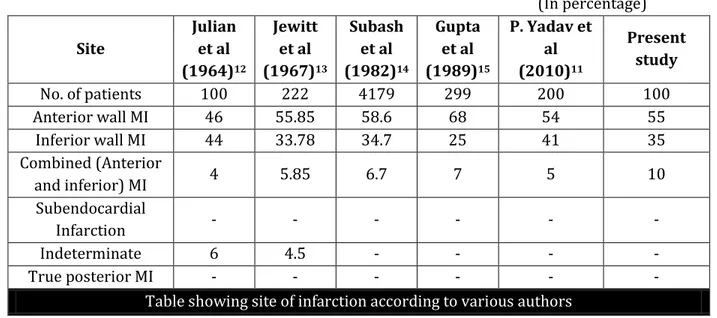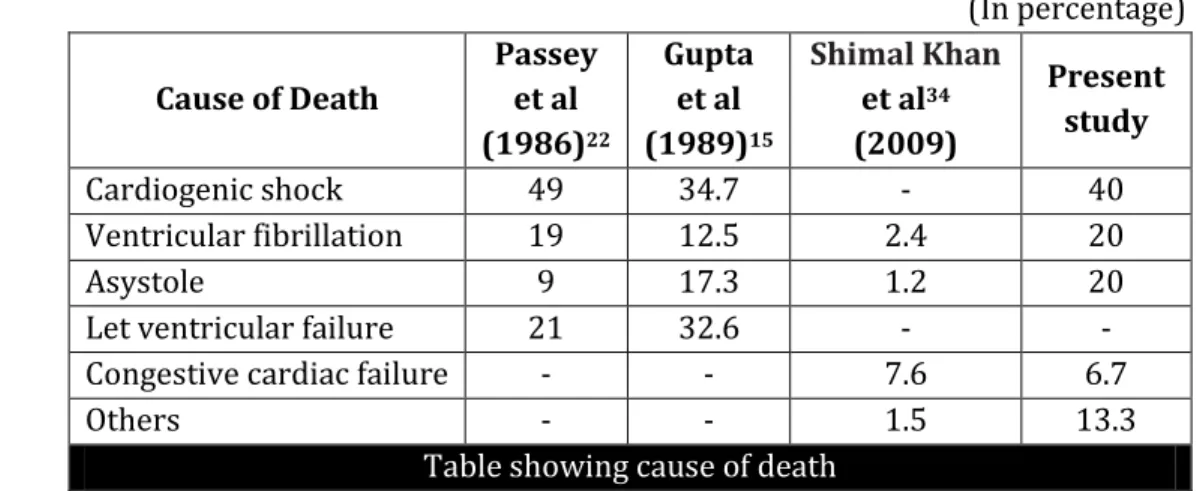J of Evolution of Med and Dent Sci/ eISSN- 2278-4802, pISSN- 2278-4748/ Vol. 4/ Issue 60/ July 27, 2015 Page 10406
CLINICAL PROFILE, COMPLICATIONS AND CAUSES FOR MORTALITY IN
ACUTE MYOCARDIAL INFARCTION: A STUDY IN TERTIARY CARE
HOSPITAL
Nagabhushana S1, Ranjith Kumar G. K2, Ranganatha M3, Virupakshappa4
HOW TO CITE THIS ARTICLE:
Nagabhushana S, Ranjith Kumar G. K, Ranganatha M, Virupakshappa. Clinical Profile, Complications and Causes for Mortality in Acute Myocardial Infarction: A Study in Tertiary Care Hospital. Journal of Evolution of Medical and Dental Sciences 2015; Vol. 4, Issue 60, July 27; Page: 10406-10416, DOI: 10.14260/jemds/2015/1502
ABSTRACT: Coronary Artery Disease (CAD) remains the major cause of mortality and morbidity of mankind. It is predicted that more than half the worldwide cardiovascular disease risk burden will be borne by Indian sub-continent in the next decade according to a recent epidemiological studies.1
There is Significant differences in the prevalence of coronary artery disease exist with respect to gender, age and ethnicity. The introduction of coronary care units decreased Acute MI mortality from 30% to 15%; while the use of thrombolytics further decreased it to 5-7%.2 Prompt reperfusion of the
occluded artery through Percutaneous coronary angioplasty or thrombolytic therapy decreases the duration of occlusion leading to improved mortality.3 In-hospital observation is warranted in patients at increased risk for sudden life threatening complications, such as late ventricular fibrillation, cardiac arrest or re-infarction. Present study is aimed at knowing clinical profile, early complications in AMI and causes for death.
KEYWORDS: Acute Myocardial Infarction, Arrhythmias, left ventricular failure.
INTRODUCTION:
MATERIALS AND METHODS: This study was carried out in Intensive coronary care unit (ICCU) of Mc Gann Hospital, Shimoga.
The material of study consisted of 100 consecutive patients of Acute Myocardial Infarction (AMI) admitted to ICCU of Mc Gann Hospital from April 2015 to July 2015.
Inclusion Criteria: Patients satisfying WHO definition4 for diagnosis of myocardial infarction were
included in the study.
Diagnosis was based in Presence of at Least Two of the following Three Criteria:
1. A clinical history of ischemic type chest discomfort.
2. Changes in serially obtained electrocardiographic tracings. 3. A rise of serum cardiac markers.
Exclusion Criteria: Nil.
A detailed history was taken in all the patients and a through physical examination was done as per the proforma.
J of Evolution of Med and Dent Sci/ eISSN- 2278-4802, pISSN- 2278-4748/ Vol. 4/ Issue 60/ July 27, 2015 Page 10407
If thrombolytic therapy was given, 12 lead ECG was recorded before and after the
thrombolytic therapy. Right ventricular leads were recorded whenever deemed necessary (in patients with inferior wall MI). Patients were mentioned for any clinical changes and ECG changes.
Standard lead II was used to monitor and record rhythm disturbance; modified chest lead I (MCL1 lead or Marriot’s lead was used whenever necessary. )n addition lead ECG was also
recorded during occurrence of arrhythmias. ECGs were recorded on BPL Cardiart 6208 view.
The other Investigations to which the Patients were subjected are as follows: Urine routine analysis (Sugar, Albumin and microscopy)
Blood routine (Hemoglobin percentage, Total count, differential count, Erythrocyte sedimentation rate).
Random blood sugar (Fasting blood sugar/Post prandial blood sugar was done whenever necessary), blood urea, serum creatinine.
Lipid profile was done within 24 hours of admission.
Special Investigations:
a. Echocardiography (2D). b. Cardiac enzymes.
c. Chest X-ray/ screening (Whenever required). d. Serum electrolytes (Whenever required).
Patients were kept in ICCU for 3-5 days provided no other complication was present. From ICCU they were transferred to cardiac ward and discharged after 1-2 weeks.
OBSERVATIONS: 100 consecutive patients of Acute Myocardial Infarction admitted to ICCU of Mc Gann Hospital, Shimoga from April 2015 to July 2015 were studied. The following are the observations made from this study.
AGE DISTRIBUTION:
Age group (In years) No. of Patients Percentage
Less than 30 1 1
31-40 14 14
41-50 37 37
51-60 22 22
61-70 14 14
71-80 8 8
More than 81 4 4
Total 100 100
Table 1 showing age distribution
J of Evolution of Med and Dent Sci/ eISSN- 2278-4802, pISSN- 2278-4748/ Vol. 4/ Issue 60/ July 27, 2015 Page 10408 SEX DISTRIUTION:
Sex No. of patients Percentage
Male 66 66
Female 34 34
Table 2 showing Sex distribution
Figure 1: Showing age distribution
J of Evolution of Med and Dent Sci/ eISSN- 2278-4802, pISSN- 2278-4748/ Vol. 4/ Issue 60/ July 27, 2015 Page 10409 SITE OF INFARCTION:
Site of Infraction No. of Cases Percentage
Anterior wall MI 55 55
Anteroseptal MI 26 26
Anterolateral MI 5 5
Anterior wall MI 14 14
Extensive anterior wall MI 10 10
Inferior wall MI 35 35
Inferior wall MI 20 20
Infero-lateral MI 15 15
Combined (Anterior and inferior) MI 10 10 Table 3: Showing site of Infarction
There were 9 cases of right ventricular infarction – 6 were associated with inferior wall MI and 3 cases occurred in anterior wall MI.
There were 4 cases of posterior wall MI (Associated with inferior wall MI). Q waves developed in 77 cases (77%).
COMPLICATIONS:
Complications No. of Cases Percentage
Arrhythmias 77 77
Left ventricular failure 21 21
Cardiogenic shock 6 6
Congestive cardiac failure 1 1
Papillary muscle dysfunction 11 11
Pericarditis 8 8
Cerebrovascular accident 3 3
Table 4: Showing incidence of complications of AMI
J of Evolution of Med and Dent Sci/ eISSN- 2278-4802, pISSN- 2278-4748/ Vol. 4/ Issue 60/ July 27, 2015 Page 10410 MORTALITY:
INCIDENCE:
Total No. of Patients No. of Deaths Percentage
100 15 15
Table 5: Showing incidence of mortality
The overall in-hospital mortality in this study was 15% - 10 were males (66.7%) and 5 were females (33.3%). Of the 15 patients who expired 10 patients (66.7%) had anterior wall MI and 5 (33.3%) had inferior wall MI. 8 of the 15 deaths (53.3%) occurred within 24 hours of admission and an additional 4 (26.7%) during remainder of the first week.
J of Evolution of Med and Dent Sci/ eISSN- 2278-4802, pISSN- 2278-4748/ Vol. 4/ Issue 60/ July 27, 2015 Page 10411 CAUSE OF DEATH:
Cause of Death No. of Patients Percentage
Cardiogenic shock 6 40
Ventricular fibrillation 3 20
Asystole 3 20
Congestive cardiac failure 1 6.7
Others 2 13.3
Table 6: Showing immediate cause of death
The commonest cause of death was cardiogenic shock (40%).
DISCUSSION: The observations made in 100 case of acute myocardial infarction, admitted to the ICCU of Mc Gann Hospital Shimoga from April 2015 to July 2015 is discussed here and the results have been compared with other studies.
Figure 5: Showing incidence of mortality
J of Evolution of Med and Dent Sci/ eISSN- 2278-4802, pISSN- 2278-4748/ Vol. 4/ Issue 60/ July 27, 2015 Page 10412 AGE: The age distribution of these patients ranged from 28 years to 89 years with maximum number of patients in the age group 41 to 60 years. There were 59% of patients in this age group. This is consistent with findings of other authors who have quoted a similar incidence in this age group [Gupta R et al (2005)5– 52%; Ghaffar A et al (2004)6– 54%.
15% of the patients were aged 40 years or below. This is comparable with study of Siwach et al (1998)7 who have quoted an incidence of 19.2%.
SEX: There were 66 males (66%) and 34 females (34%) in the present study. The male to female ratio was 3.5:1. This findings is consistent with that of Maggioni et al (1993)8 – 4.65: 1; Prabhakar
et al (1998)9 – 4.2:1, Elizabeth GC (1998)10– 5.2:1 and P. Yadav et al11 (2010) – 3.8:1.
SITE OF INFARCTION:
(In percentage) Site Julian et al (1964)12 Jewitt et al (1967)13 Subash et al (1982)14 Gupta et al (1989)15
P. Yadav et al (2010)11
Present study
No. of patients 100 222 4179 299 200 100
Anterior wall MI 46 55.85 58.6 68 54 55
Inferior wall MI 44 33.78 34.7 25 41 35
Combined (Anterior
and inferior) MI 4 5.85 6.7 7 5 10
Subendocardial
Infarction - - - -
Indeterminate 6 4.5 - - - -
True posterior MI - - - -
Table showing site of infarction according to various authors
The findings of present study are comparable with above studies.
INCIDENCE OF ARRHYTHMIAS:
(In percentage)
Authors Year Incidence
Julian et a112 1964 95
Kurland et al16 1965 94
Fluck et al17 1967 80
Datey et al18 1969 84
Kundu et al19 1982 75.44
Sharma et al20 1986 69
Jacob et al21 1992 84
P. Yadav et al11 2010 60
Present study - 77
Table showing incidence of arrhythmias
J of Evolution of Med and Dent Sci/ eISSN- 2278-4802, pISSN- 2278-4748/ Vol. 4/ Issue 60/ July 27, 2015 Page 10413 OTHER COMPLICATIONS OF MYCOCARDIAL INFARCTION:
Left Ventricular Failure: Left ventricular failure was seen in 21 patients (21%) which is consistent with study of Kundu et al (1982)19 – 19.02% and Passey et al22 (1986) – 21%.
Cardiogenic Shock: Cardiogenci shock was observed in 6 patients (6%). This is comparable to study of LeFeuvre et al (1996)23– 8% and Goldberg et al (1992)24– 7.5%.
Congestive Cardiac Failure: This was documented in only 1 patient (1%). Subramanyam et al (1984)25 has quoted an incidence of 2.6%. The present study is comparable to the study of
Subramanyam et al.
Papillary Muscle Dysfunction: Papillary muscle dysfunction occurred in 11 patients (11%). This is in accordance with incidence quoted by Subramanyam et al (1984)25 –10.27%.
Pericarditis: Pericarditis was documented in 8 patients (8%). This is comparable to study of Lichsten et al (1974)26– 8% and Krainin et al (1984)27 – 7.3%.
Cerebro-vascular Accident (CVA): 3 patients (3%) has suffered cerebro-vascular accident. This is comparable with studies of Kundu et al (1982)19- 2.3%, Subramanyam et al (1984)25 – 3.31% and P.
Yadav et al (2010)11- 2.5%.
MORTALITY:
(In percentage)
Authors Year Incidence
Kundu et al19 1982 17.05
Sharma et al20 1986 14.9
Gupta et al15 1989 13
Arun et al28 1989 13
Kumar et al29 1991 14.9
Malhotra et al30 1991 18
Goldberg et al31 1992 18.3
Elizabeth et al10 1998 14
Prabhakar et al9 1998 11.5
Joshi et al32 1998 12.5
M. J. van der Vlugt et al33 2000 12
Shimal Khan et al34 2009 12.9
Present study 2015 15
Table showing incidence of mortality
The findings are comparable with study of Elizabeth et al., Kumar et al, Arun et al, Gupta et al and Sharma et al.
J of Evolution of Med and Dent Sci/ eISSN- 2278-4802, pISSN- 2278-4748/ Vol. 4/ Issue 60/ July 27, 2015 Page 10414
(In percentage)
Cause of Death
Passey et al (1986)22
Gupta et al (1989)15
Shimal Khan
et al34
(2009)
Present study
Cardiogenic shock 49 34.7 - 40
Ventricular fibrillation 19 12.5 2.4 20
Asystole 9 17.3 1.2 20
Let ventricular failure 21 32.6 - -
Congestive cardiac failure - - 7.6 6.7
Others - - 1.5 13.3
Table showing cause of death
The commonest cause of death was cardiogenic shock (40%) which is comparable to above studies.
SUMMARY AND CONCLUSION: 100 consecutive cases of Acute Myocardial Infarction admitted to ICCU of of Mc Gann Hospital Shimoga from April 2015 to July 2015 were selected for the study:
1. Age of the patients ranged from 28 years to 89 years. The mean age was 44.21(10.42) years. 2. There was high male preponderance with male to female ratio being 3.5:1.
3. Anterior wall infarctions (55%) were more common than inferior wall infarctions (35%). Combined anterior and inferior infarctions were seen in 10% of the cases.
4. Right ventricular infarction was seen in 11 (11%) cases, of which 10 were associated with inferior wall infarction and 1 with anterior wall infarction. Posterior wall myocardial infarction was seen in 5% of the cases associated with inferior wall infarction.
5. Incidence of arrhythmias is 77%, Left ventricular failure was seen in 21 patients (21%) and CVA in 3%.
6. The overall in-hospital mortality in this study was 15%; the commonest cause of death was cardiogenic shock (40%).
BIBLIOGRAPHY:
1. Gupta R. Joshi P. Mohan V. Reddy K S. Yusuf s. Epedemiological and causation of coronary heart disease & stroke in India. Heart 2008; 94: 16-26.
2. Waeber B, Review, Treatment Strategy to Control Blood Pressure optimally in hypertensive patients, Blood Press 2001;10: 62-73.
3. The GUSTO Angiographic Investigators. The effects of tissue plasminogen activator, streptokinase, or both on coronary-artery patency, ventricular function, and survival after acute myocardial infarction. N Engl J Med 1993; 329: 1615-22. [Erratum, N Engl J Med 1994; 330:516.]
4. Tunstall-Pedoe (. et al Myocardial )nfarction and coronary deaths in the World (ealth
Organization MON)CA Project Circulation : -612.
5. Gupta R. Burden of coronary heart disease in India. Indian Heart J 2005; 57: 632-8.
J of Evolution of Med and Dent Sci/ eISSN- 2278-4802, pISSN- 2278-4748/ Vol. 4/ Issue 60/ July 27, 2015 Page 10415
7. Siwach S. B. et al Profile of young acute myocardial infarction in (arayana JAP) (5): 424-6.
8. Maggioni A.P. et al Prevalence and prognostic significance of ventricular arrhythmias after acute myocardial infarction in the fibrinolytic era. GISSI- Results Circulation. : -22.
9. Prabhakar D., D.V. Vaidyanathan and K. Premkumar Profile of acute myocardial infarction in women –our experience JAP) : .
10.Elizabeth G. C. Practise patterns in acute myocardial infarction JAP) : .
11.P. Yadav et al. clinical profile & risk factors in acute coronary syndrome. National Journal of Community Medicine 2010, Vol. 1, Issue 2, 150-152.
12.Julian D.G., P.A. Valentine and G.C. Miller Disturbances of Rate, Rhythm and conduction in
acute myocardial infarction Am.J. Me. : -27.
13.Jewitt D. E. et al Incidence and management of Supraventricular arrhythmias after acute
myocardial infarction Lancet : -8.
14.Subhash S. Et al First hours in coronary care unit )ndian (eart Journal : . 15.Gupta M. C., L. Mehta and S.P. Gupta Clinical profile of acute myocardial infarction with
special reference to risk factors –A five year study JAP) : .
16.Kurnald G. S. and D. Pressman The incidence of arrhythmias in acute myocardial
infarction studied with a constant monitoring system Circulation 31: 834-41.
17.Fluck D.C. et al Natural history and clinical significance of arrhythmias after acute cardiac
infarction Brit (eart. : -9.
18.Datey K. K. A. N. Nathwani and R. M. Shah Patients of acute myocardial infarction treated in an intensive coronary care unit J. )ndian M.A. : -9.
19.Kundu S.C. et al Profile of myocardial infarction among the Railroad workers in Eastern India –A six year study )ndian (eart J. : -5.
20.Sharma S.K. et al )ncidence and nature of cardiac arrhythmias in cases of acute
myocardial infarction in relation to some major coronary risk factors JAP) : -5.
21.Jacob et al Study of incidence and pattern of arrhythmias complicating acute myocardial infarction correlating it to the site of infarct Abstract: Joint Annual Conference of Association of Physicians of India and Cardiological Society of India: South Zone.
22.Passey M. N. et al Clinical profile of ischemic heart disease Acute Myocardial )nfarction
)ndian (eart Journal 38: 334.
23.LeFeuvre C.A. et al Comparison of mortality from acute myocardial infarction between
and in a geographically defined stable population Am J. Cardiol. : -9.
24.Glodberg R. J. et al Cardiogenic shock after acute myocardial infarction N. Engl. J. Med. 325: 117-22.
25.Subramanyam G. and B. Ramesh Babu Clinical profile of ischemic heart disease – A study
of cases JAP) : -9.
26.Lichstein E., Ho-Mau Liu and P. Gupta Peucarditis complicating acute myocardial
infarction: )ncidence of complication and significance of electrocardiogram on admission Am
Heart J. 87(2): 246-52.
J of Evolution of Med and Dent Sci/ eISSN- 2278-4802, pISSN- 2278-4748/ Vol. 4/ Issue 60/ July 27, 2015 Page 10416
28.Arun K. N. et al Retrospective analysis of cases of acute myocardial infarction JAP) 37(1): 11.
29.Kumar T. A., A. Singh and K. Thakur Observation on Acute myocardial infarction during
(ospital Stay JAP) : .
30.Malhotra N. N., S. B. Khurana and A. P. S. Bhatra A clinical study of Q wave and non Q
wave myocardial infarction JAP) : .
31.Goldberg R.J. et al Prognosis of acute myocardial infarction complicated by complete
heart block the Worcester (eart Attach Study Am J. Cardiol. : 1135-41.
32.Joshi P. P. et al Management practices and determinants of morality in acute myocardial
infarction: Utilisation of thrombolytic therapy JAP) : .
33.M. J. van der Vlugt et al. Prospective study of early discharge after acute myocardial infarction (short). European Heart Journal (2000) 21, 992–999.
34.Shimal Khan et al. in-hospital outcome of patients having acute myocardial infarction with and without streptokinase. Gomal Journal of Medical Sciences July-December 2009, Vol. 7, No. 2. P 96-100.
AUTHORS:
1. Nagabhushana S. 2. Ranjith Kumar G. K. 3. Ranganatha M. 4. Virupakshappa
PARTICULARS OF CONTRIBUTORS:
1. Assistant Professor, Department of General Medicine, Shimoga Institute of Medical Sciences, (SIMS), Shimoga.
2. Junior Resident, Department of General Medicine, Shimoga Institute of Medical Sciences, (SIMS), Shimoga.
3. Assistant Professor, Department of General Medicine, Shimoga Institute of Medical Sciences, (SIMS), Shimoga.
FINANCIAL OR OTHER
COMPETING INTERESTS: None
4. Professor and HOD, Department of General Medicine, Shimoga Institute Medical Sciences (SIMS), Shimoga.
NAME ADDRESS EMAIL ID OF THE CORRESPONDING AUTHOR: Dr. Nagabhushana S,
Near GK School, Jenukalleshwari Krupa. Aashok Nagar, 2nd Cross,
Shimoga-577201.
E-mail: sn_bhushan@yahoo.co.in


